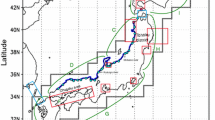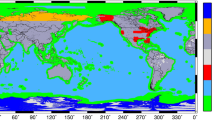Abstract
Numerical models and correct predictions are important for marine forecasting, but the forecasting results are often unable to satisfy the requirements of operational wave forecasting. Because bias between the predictions of numerical models and the actual sea state has been observed, predictions can only be released after correction by forecasters. This paper proposes a spatiotemporal interactive processing bias correction method to correct numerical prediction fields applied to the production and release of operational ocean wave forecasting products. The proposed method combines the advantages of numerical models and Forecast Discussion; specifically, it integrates subjective and objective information to achieve interactive spatiotemporal corrections for numerical prediction. The method corrects the single-time numerical prediction field in space by spatial interpolation and sub-zone numerical analyses using numerical model grid data in combination with real-time observations and the artificial judgment of forecasters to achieve numerical prediction accuracy. The difference between the original numerical prediction field and the spatial correction field is interpolated to an adjacent time series by successive correction analysis, thereby achieving highly efficient correction for multitime forecasting fields. In this paper, the significant wave height forecasts from the European Centre for Medium-Range Weather Forecasts are used as background field for forecasting correction and analysis. Results indicate that the proposed method has good application potential for the bias correction of numerical predictions under different sea states. The method takes into account spatial correlations for the numerical prediction field and the time series development of the numerical model to correct numerical predictions efficiently.
Similar content being viewed by others
References
Americal Meteorlogical Society, 2002. Implementation challenges of IFPS at a forecast office with complex terrain. https://ams.confex.com/ams/annual2002/webprogram/Paper27252.html.
Bannister, R. N., Chipilski, H. G., and Martinez-Alvarado, O., 2020. Techniques and challenges in the assimilation of atmospheric water observations for numerical weather prediction towards convective scales. Quarterly Journal of the Royal Meteorological Society, 146 (726): 1–48.
Ben Alaya, M. A., Cheban, F., and Ouarda, T. B. M. J., 2015. Probabilistic multisite statistical downscaling for daily precipitation using a Bernoulli-generalized Pareto multivariate autoregressive model. Journal of Climate, 28 (6): 2349–2364.
Benjamin, S. O., and Seaman, N. L., 1985. A simple scheme for objective analysis in curved flow. Monthly Weather Review, 113 (7): 1184.
Bourgin, F., Ramos, M. H., Thirel, G., and Andreassian, V., 2014. Investigating the interactions between data assimilation and post-processing in hydrological ensemble forecasting. Journal of Hydrology, 519: 2775–2784.
Briggs, I. C., 2012. Machine contouring using minimum curvature. Geophysics, 39 (1): 39–48.
Chattopadhyay, A., Nabizadeh, E., and Hassanzadeh, P., 2020. Analog forecasting of extreme-causing weather patterns using deep learning. Journal of Advances in Modeling Earth Systems, 12 (2): e2019MS001958, https://doi.org/10.1029/2019MS001958.
Chen, S. H., Yang, S. C., Chen, C. Y., van Dam, C. P., Cooperman, A., Shiu, H., et al., 2019. Application of bias corrections to improve hub-height ensemble wind forecasts over the Tehachapi Wind Resource Area. Renewable Energy, 140: 281–291.
Chu, Y. Q., Li, C. C., Wang, Y. F., Li, J., and Li, J., 2016. A long-term wind speed ensemble forecasting system with weather adapted correction. Energies, 9 (11): 894, https://doi.org/10.3390/en9110894.
Cui, B., Toth, Z., Zhu, Y., and Hou, D. C., 2011. Bias correction for global ensemble forecast. Weather and Forecasting, 27 (2): 396–410.
Du, P. J., Wang, L. L., Guan, Q. L., Xue, J. L., Chen, X. E., Kang, X., et al., 2013. Development and applications of an interactive operational forecast system on typhoon induced wave. Periodical of Ocean University of China, 43 (10): 16–24 (in Chinese with English abstract).
Duan, Q., Di, Z., Quan, J., Wang, C., Gong, W., Gan, Y., et al., 2017. Automatic model calibration: A new way to improve numerical weather forecasting. Bulletin of the American Meteorological Society, 98 (5): 959–970.
Durai, V. R., and Bhradwaj, R., 2014. Evaluation of statistical bias correction methods for numerical weather prediction model forecasts of maximum and minimum temperatures. Natural Hazards, 73 (3): 1229–1254.
Epstein, E. S., 1969. Stochastic dynamic prediction. Tellus, 21 (6): 739–759.
Fei, L., 2018. Spatial interpolation algorithm research of ArcGIS engine. IHIP 2018: 2018 International Conference on Information Hiding and Image Processing. University of Salford, Manchester, 97–99.
Gao, S., Dai, K., and Xue, F., 2014. The design and development of grid edit platform based on MICAPS 3.2 system. Meteorological Monthly, 40 (9): 1152–1158 (in Chinese with English abstract).
Goyal, M., Panchariya, V., Sharma, A., and Singh, V., 2018. Comparative assessment of SWAT model performance in two distinct catchments under various DEM scenarios of varying resolution, sources and resampling methods. Water Resources Management, 32 (2): 805–825.
Guan, H., Cui, B., and Zhu, Y. J., 2015. Improvement of statistical postprocessing using GEFS reforecast information. Weather and Forecasting, 30 (4): 841–854.
Hart, K. A., Streenburgh, W. J., Onton, D. J., and Siffert, A. J., 2004. An evaluation of mesoscale-model-based model output statistics (MOS) during the 2002 Olympic and Paralympic Winter Games. Weather and Forecasting, 19 (2): 200–218.
He, Y. N., Gao, S., Xue, F., Zhao, S. R., Liu, M., Hu, H., et al., 2018. Design and implementation of intelligent grid forecasting platform based on MICAPS4. Journal of Applied Meteorological Science, 29 (1): 13–24 (in Chinese with English abstract).
Hu, S. J., Qiu, C. Y., Zhang, L. Y., Huang, Q. C., Yu, H. P., and Chou, J. F., 2014. An approach to estimating and extrapolating model error based on inverse problem methods: Towards accurate numerical weather prediction. Chinese Physics B, 23 (8): 89201.
Irmak, A., Ranade, P. K., Marx, D., Irmak, S., Hubbard, K. G., Meyer, G. E., et al., 2010. Spatial interpolation of climate variables in Nebraska. Transactions of the Asabe, 53 (6): 1759–1771.
Jin, R. H., Dai, K., Zhao, R. X., Cao, Y., Xue, F., Liu, C. H., et al., 2019. Progress and challenge of seamless fine gridded weather forecasting technology in China. Meteorological Monthly, 45 (4): 445–457 (in Chinese with English abstract).
Krishnamurti, T. N., Sanjay, J., Mitra, A. K., and Vijay Kumar, T. S. V., 2004. Determination of forecast errors arising from different components of model physics and dynamics. Monthly Weather Review, 132 (11): 2570–2594.
Leith, C. E., 1974. Theoretical skill of Monte Carlo forecasts. Monthly Weather Review, 102 (6): 409, DOI: https://doi.org/10.1175/1520-0493(1974)102<0409:TSOMCF>2.0.CO;2.
Li, P. C., and Liu, X. D., 2018. Bilinear interpolation method for quantum images based on quantum Fourier transform. International Journal of Quantum Information, 16: 1850031, DOI: https://doi.org/10.1142/S0219749918500314.
Li, Z. X., He, Y. Q., Xin, H. J., Wang, C. F., Jia, W. X., Zhang, W., et al., 2010. Spatio-temporal variations of temperature and precipitation in Mts. Hengduan Region during 1960–2008. Acta Geographica Sinica, 65 (5): 563–579.
Liu, G. L., Chen, B. Y., Wang, L. P., Zhang, S. F., Zhang, K. Y., and Lei, X., 2019. Wave height statistical characteristic analysis. Journal of Oceanology and Limnology, 37 (2): 448–460.
Liu, Z. H., Huang, R. G., Hu, Y. M., Fan, S. D., and Feng, P. H., 2011. Generating high spatiotemporal resolution LAI based on MODIS/GF-1 data and combined Kriging-Cressman interpolation. International Journal of Agricultural and Biological Engineering, 9 (5): 120–131.
Mass, C. F., 2003. IFPS and the future of the national weather service. Weather and Forecasting, 18 (1): 75–79.
Mass, C. F., Ovens, D., Westrick, K., and Colle, B., 2002. Does increasing horizontal resolution produce more skillful forecasts? Bulletin of the American Meteorological Society, 83 (3): 407–430.
Pan, B. X., Hsu, K., AghaKouchak, A., and Sorooshian, S., 2019. Improving precipitation estimation using convolutional neural network. Water Resources Research, 55 (3): 2301–2321.
Rukundo, O., and Schmidt, S. E., 2018. Effects of rescaling bilinear interpolant on image interpolation quality. Optoelectronic Imaging and Multimedia Technology V, 10817: 11–12.
Schulze, G. C., 2007. Atmospheric observations and numerical weather prediction. South African Journal of Science, 103: 318–323.
Smith, W. H. F., and Wessel, P., 1990. Gridding with continuous curvature splines in tension. Geophysics, 55 (3): 293–305.
Susanto, F., de Souza, P., and He, J., 2016. Spatiotemporal interpolation for environmental modelling. Sensors, 16: 1245, https://doi.org/10.3390/s16081245.
Tang, B. H., and Bassill, N. P., 2018. Point downscaling of surface wind speed for forecast applications. Journal of Applied Meteorology Climatology, 57 (3): 659–674.
Terzopoulos, D., 1988. The computation of visible-surface representations. IEEE Transactions on Pattern Analysis and Machine Intelligence, 10 (4): 417–438.
Wang, H., Liu, N., Li, B. X., and Li, X., 2014. An overview of ocean predictability and ocean ensemble forecast. Advances in Earth Science, 29 (11): 1212–1225.
Wang, T. W., Gao, S., Xu, J. L., Li, Y. R., Li, P., and Ren, P., 2018. Correcting predictions from oceanic maritime numerical models via residual learning. OCEANS-MTS/IEEE Kobe Techno-Oceans. Kobe, Japan.
World Meteorological Organization (WMO), 2015. Seamless prediction of the earth system: From minutes to months. https://library.wmo.int/index.php?lvl=notice_display&id=17276#.XzPlq_kzaUk.
Wu, W., Wu, Z. M., Gao, S. H., and Zheng, Y., 2013. A homogeneous linear estimation method for system error in data assimilation. Journal of Ocean University of China, 12 (3): 335–344.
Yang, S. B., Xia, T. L., Zhang, Z. Q., Zheng, C. W., Li, X. F., Li, H. Y., et al., 2019a. Prediction of significant wave heights based on CS-BP model in the South China Sea. IEEE Access, 7: 147490–147500.
Yang, S. B., Zhang, Z. Q., Fan, L. L., Xia, T. L., Duan, S. H., Zheng, C. W., et al., 2019b. Long-term prediction of significant wave height based on SARIMA model in the South China Sea and adjacent waters. IEEE Access, 7: 88082–88092.
Yu, Z. C., Zhong, S. B., Wang, C. L., Yang, Y. S., Yao, G. N., and Huang, Q. Y., 2017. Mapping comparison and meteorological correlation analysis of the air quality index in mid-eastern China. ISPRS International Journal of Geo-Information, 6 (2): 52, https://doi.org/10.3390/ijgi6020052.
Zhang, H. L., and Pu, Z. X., 2010. Beating the uncertainties: Ensemble forecasting and ensemble-based data assimilation in modern numerical weather prediction. Advances in Meteorology, 2010: 432160, DOI: https://doi.org/10.1155/2010/432160
Zhang, H. R., Lu, L. J., Liu, Y. H., and Liu, W., 2015. Spatial sampling strategies for the effect of interpolation accuracy. ISPRS International Journal of Geo-Information, 4 (4): 2742–2768.
Zoraster, S., 2003. A surface modeling algorithm designed for speed and ease of use with all petroleum industry data. Computers & Geosciences, 29 (9): 1175–1182.
Acknowledgements
This work was supported by the National Key Research and Development Program of China (No. 2018YFC1407 002), the National Natural Science Foundation of China (Nos. 62071279, 41930535), and the SDUST Research Fund (No. 2019TDJH103).
Author information
Authors and Affiliations
Corresponding author
Rights and permissions
About this article
Cite this article
Ai, B., Yu, M., Guo, J. et al. A Spatiotemporal Interactive Processing Bias Correction Method for Operational Ocean Wave Forecasts. J. Ocean Univ. China 21, 277–290 (2022). https://doi.org/10.1007/s11802-022-4827-3
Received:
Revised:
Accepted:
Published:
Issue Date:
DOI: https://doi.org/10.1007/s11802-022-4827-3




